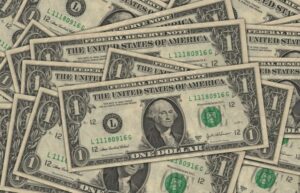Written by: Corey Janoff
This post was originally published on our previous blog website on January 3, 2018 and has since not been revised and/or updated.
Happy New Year! As many of you start implementing your New Year’s Resolutions that you hope to stick with past February, I’m sure some of you have some financial goals in mind for 2018. I would guess spending less on certain things and saving more money sums up the majority of financial goals for people. So how can we go about doing that and what can the long-term impact be?
Save a Dollar a Day
Let’s say you find a way to save one dollar every day of the year. Maybe you cut back on the trips to Starbucks. (If you didn’t read my blog post last year, “Is Starbucks Killing my Finances?” I suggest checking it out). Maybe you make your lunch at home and bring it to work instead of going out to lunch. Maybe when you go out to eat you drink water instead of ordering a soft drink or alcoholic beverage. All of these moves would result in saving more than $1.00 each time, but let’s start small and work our way up.
Now, let’s take that single dollar and send it into an investment account every day. One dollar per day, 365 days per year. For those math whizzes out there, you probably quickly and accurately concluded that is $365 per year. If we continue to do this every day for the next 30 years and invest that money in a hypothetical investment account that averages a 7% rate of return each year, we would have around $35,000 30 years from now!
And that is assuming you only invest $365 once per year. If you invest one dollar every day and it grows throughout the year, you would have over $37,000 in 30 years. Time value of money and the miracle of compound interest. The sooner you can invest, the more time it has to potentially grow.
If you let that money continue to grow for another 30 years (60 years from now, assuming you are still alive), you would have $300,000 invested! That is quite a bit of money to leave behind to a charity! Way more than I would have if I didn’t spend $5,000 on liquor.
Save Two Dollars a Day
Man, a little bit can really add up over time. That was only one dollar. What if we can save two dollars every day? Annual compounding would give us close to $70,000 in 30 years. Daily compounding would give us close to $75,000. $680,000 in 60 years (with daily compounding – $594,000 with annual compounding).
Save Three Dollars a Day
What if we can save $3 per day? It may not happen each and every day, but one day you save $1, another day you save $5, another day you save $4 – it averages out to $3/day. You will have over $100,000 invested in 30 years and between $900,000-1,000,000 in 60 years, depending on the frequency of the investment.
Three dollars a day is $90/month. If we round up to $100/month and invest it, that will give us an additional $122,000 in 30 years. It will add up to $1.1 million in 60 years. This of course assumes we continue to add to the account over that time span. It would only grow to $990,000 by year 60 if you stop investing $100/month after 30 years.
Save Ten Dollars a Day
What if we can save ten dollars a day? That will take a little more effort than one or three dollars, but I think it’s doable. If I buy a new pair of shoes for work every year, I could spend $100 instead of $300 and invest that $200 I didn’t spend. That is 20 days’ worth of saving ten dollars right there.
If instead of going out to a restaurant for a date night, we order a pizza and buy a bottle of wine at the store and spend $40 total instead of $100. Take that $60 of money we didn’t spend and invest it. That is six days’ worth of saving $10 a day.
If I make spaghetti for dinner a little more often and save the leftovers for lunch the next three days, that will be $30 I don’t spend buying lunches the next few days.
In these three examples, we have approximately one month of saving $10/day. Ten dollars a day, multiplied by 365 days a year is $3,650/year. Or a hair over $304/month. If we invest that money for the next 30 years, averaging a 7% annualized rate of return, the investment will grow to over $370,000. It will add up to over $3,000,000 in 60 years.
#Math
This is a fun game to play! If we save $15/day, that gives us over $550,000 in 30 years. $30/day gives us over $1.1 million in 30 years. This can be the new 30 for 30. $30 a day for 30 years. It will make you a millionaire.
If you want an exciting weekend activity, look at all the spending you did in 2017. Download your bank account and credit card statements to a spreadsheet and see what you spent money on. Look at the different spending categories (clothing, groceries, restaurants, utilities, entertainment, etc.). See any surprises? Did you spend way more money on McDonald’s breakfasts than you care to admit?
Which of these expenses can you scale back on, or replace with less expensive alternatives? You can find ways to save money that don’t materially affect your lifestyle. Lower the temperature on your thermostat by one or two degrees in the winter. Put on a sweatshirt. You’ll survive. Try to shave a minute off of your showers every day. Be sure to turn off lights when you leave a room. Turn off and unplug appliances when you are done with them. These minor actions will save you more than you think on your utility bills each month.
The key is to take that savings and invest it. People find ways to save money all the time, but they end up spending that money in other ways.
“I cut the cord and cancelled my cable subscription, which saves me $70/month!” That is great….if you put that $70/month toward something productive, like a long-term investment or paying down high interest rate debt. But if that $70/month gets added to your budget for restaurants, or goes to your vacation fund, I’m not sure you are really “improving” your financial picture.
If you have read this far, you have seen the numbers. Little bits can add up to great big heaps over time. We just need to be disciplined and stick to it and we will be very pleased with the end results.
Disclosures:
Any examples are hypothetical and for illustrative purposes only. Any investment involves potential losses, including total loss of principal. Consult with your financial advisor before implementing any financial or investment strategy.



